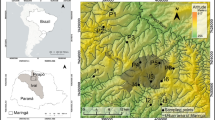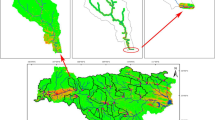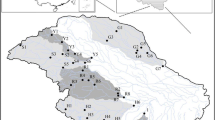Abstract
Changes in LULC and landscape factors impact water quality at spatial and temporal scales. In this study, we investigated the current status in water quality for sub-watersheds of the southern portion of the Nyong River basin of Cameroon from 1994 to 2014 using the WHO guideline. The trends in the water quality parameters were explored using Mann-Kendall test, and their relationship with changes in LULC and landscape factors were analysed using multiple linear regression and Pearson correlation. The current status in water quality did not exceed the WHO guideline limits for drinking water despite a 16% decrease in forest cover and 10% increase in agricultural areas during the period of record. The concentration and changes in water quality trends varied significantly among the sub-watersheds. The concentration of Ca2+, Mg2+, Na+, SiO2, K+, DOC, SPM and WT showed significantly increasing trends in the Nsimi small sub-watershed, while only Ca2+, Mg2+, Na+ and NO3− showed significantly increasing trends in the large sub-watersheds of Mbalmayo and Olama. A combination of one to five LULC and landscape factors, including changes in urban cover, young secondary forest, slope, elevation and population explained 10 to 70% of the changes in water quality trends at watershed scale. Although the interaction of LULC and landscape factors seems to have low impact on the water quality so far, maintaining greater than 70% forest cover and appropriate fallow farming system is invaluable to protecting water quality in the Nyong River basin in the Congo basin and in other forest-rich regions.







Similar content being viewed by others
References
Ako, A. A., Shimada, J., Hosono, T., Kagabu, M., Ayuk, A. R., Nkeng, G. E., Eyong, G. E. T., & Takounjou, A. L. F. (2012). Spring water quality and usability in the Mount Cameroon area revealed by hydrogeochemistry. Environmental Geochemistry and Health, 34(5), 615–639. https://doi.org/10.1007/s10653-012-9453-3.
Attua, E. M., Ayamga, J., & Pabi, O. (2014). Relating land use and land cover to surface water quality in the Densu River basin, Ghana. International Journal of River Basin Management, 12(1), 57–68. https://doi.org/10.1080/15715124.2014.880711.
Bu, H., Meng, W., Zhang, Y., & Wan, J. (2014). Relationships between land use patterns and water quality in the Taizi River basin, China. Ecological Indicators, 41, 187–197. https://doi.org/10.1016/j.ecolind.2014.02.003.
Chen, J., & Lu, J. (2014). Effects of land use, topography and socio-economic factors on river water quality in a mountainous watershed with intensive agricultural production in East China. PLoS One, 9, e102714. https://doi.org/10.1371/journal.pone.0102714.
Ewane, B. E., & Lee, H. H. (2020). Assessing land use/land cover change impacts on the hydrology of Nyong River basin, Cameroon. Journal of Mountain Science, 16, 50–67. https://doi.org/10.1007/s11629-019-5611-8.
Fatehi, I., Amiri, B. J., Alizadeh, A., & Adamowski, J. (2015). Modeling the relationship between catchment attributes and in-stream water quality. Water Resource Management, 29(11), 5055–5072. https://doi.org/10.1007/s11269-015-1103-y.
Galloway, J. N., Aber, J. D., Erisman, J. W., Seitzinger, S. P., Howarth, R. W., Cowling, E. B., & Cosby, B. J. (2003). The nitrogen cascade. American Institute of Biological Sciences Bullitin, 53, 341–356. https://doi.org/10.1641/0006-3568(2003)053[0341:TNC]2.0.CO;2.
Grabowski, Z. J., Watson, E., & Chang, H. (2016). Using spatially explicit indicators to investigate watershed characteristics and stream temperature relationships. Science of Total Environment, 551–552, 376–386. https://doi.org/10.1016/j.scitotenv.2016.02.042.
Granger, S. J., Bol, R., Anthony, S., Owens, P. N., White, S. M., & Haygarth, P. M. (2010). Chapter 3 - Towards a holistic classification of diffuse agricultural water pollution from intensively managed grasslands on heavy soils. In Agronomy BT-A (Ed.), Advances in Agronomy (pp. 83–115). San Diego: Academic Press.
Hua, A. K. (2017). Land use land cover changes in detection of water quality: a study based on remote sensing and multivariate statistics. Journal of Environmental and Public Health, 2017, 1–13. https://doi.org/10.1155/2017/7515130.
Lintern, A., Webb, J. A., Ryu, D., Liu, S., Bende-Michl, U., Waters, D., Leahy, P., Wilson, P., & Western, A. W. (2018). Key factors influencing differences in stream water quality across space. Wiley Interdisciplinary Reviews: Water, 5(1), e1260. https://doi.org/10.1002/wat2.1260.
Liu, J., Zhang, X., Xia, J., Wu, S., She, D., & Zou, L. (2016). Characterizing and explaining spatio-temporal variation of water quality in a highly disturbed river by multi-statistical techniques. Springer Plus, 5, 1171. https://doi.org/10.1186/s40064-016-2815-z.
Mainali, J., & Chang, H. (2018). Landscape and anthropogenic factors affecting spatial patterns of water quality trends in a large river basin, South Korea. Journal of Hydrology, 564, 26–40. https://doi.org/10.1016/j.jhydrol.2018.06.074.
Maréchal, J. C., Braun, J. J., Riotte, J., Bedimo, J. P. B., & Boeglin, J. L. (2011). Hydrological processes of a rainforest headwater swamp from natural chemical tracing in Nsimi watershed, Cameroon. Hydrological Processes, 25, 2246–2260. https://doi.org/10.1002/hyp.7989.
Namugizea, J. N., Jewitta, G., & Graham, M. (2018). Effects of land use and land cover changes on water quality in the uMngeni river catchment, South Africa. Physics and Chemistry of the Earth, 105, 247–264. https://doi.org/10.1016/j.pce.2018.03.013.
Peterson, E. E., Sheldon, F., Darnell, R., Bunn, S. E., & Harch, B. D. (2011). A comparison of spatially explicit landscape representation methods and their relationship to stream condition. Freshwater Biology, 56, 590–610. https://doi.org/10.1111/j.1365-2427.2010.02507.x.
Pratt, B., & Chang, H. (2012). Effects of land cover, topography, and built structure on seasonal water quality at multiple spatial scales. Journal of Hazardous Materials, 209–210, 48–58. https://doi.org/10.1016/j.jhazmat.2011.12.068.
Preston, S.D., & Brakebill, J.W. (1999). Application of spatially referenced regression modeling for the evaluation of total nitrogen loading in the Chesapeake Bay Watershed [WWW Document]. URL http://md.water.usgs.gov/publications/wrir-99- 4054/html/ (accessed 25.11.18).
Rahmanian, N., Ali, S. H. B., Homayoonfard, M., Ali, N. J., Rehan, M., Sadef, Y., & Nizami, A. S. (2015). Analysis of physiochemical parameters to evaluate the drinking water quality in the State of Perak, Malaysia. Journal of Chemistry, 10, 1–10. https://doi.org/10.1155/2015/716125.
Riebe, C. S., Kirchner, J. W., & Finkel, R. C. (2004). Erosional and climatic effects on long-term chemical weathering rates in granitic landscapes spanning diverse climate regimes. Earth and Planetary Science Letters, 224(3-4), 547–562. https://doi.org/10.1016/j.epsl.2004.05.019.
Shi, W., Xia, J., & Zhang, X. (2016). Influences of anthropogenic activities and topography on water quality in the highly regulated Huai River basin, China. Environmental Science and Pollution Research, 23, 21460–21474. https://doi.org/10.1007/s11356-016-7368-8.
Silva, L., & Williams, D. D. (2001). Buffer zone versus whole catchment approaches to studying land use impact on river water quality. Water Resources, 35(14), 3462–3472. https://doi.org/10.1016/S0043-1354(01)00062-8.
Singh, S., & Chang, H. (2014). Effects of land cover change on water quality in urban streams at two spatial scales. International Journal of Geospatial Environmental Research, 1(1), 1–21 https://dc.uwm.edu/ijger/vol1/iss1/8.
Sorlini, S., Palazzini, D., Sieliechi, J. M., & Ngassoum, M. B. (2013). Assessment of physical-chemical drinking water quality in the Logone Valley (Chad-Cameroon). Sustainability, 5, 3060–3076. https://doi.org/10.3390/su5073060.
Viers, J., Dupré, B., Braun, J.-J., Deberdt, S., Angeletti, B., Ngoupa, J. N., & Michard, A. (2000). Major and trace element abundances, and strontium isotopes in the Nyong basin rivers (Cameroon): constraints on chemical weathering processes and elements transport mechanisms in humid tropical environments. Chemical Geology, 169, 211–241.
WHO. (1997). Guideline for drinking water quality. Health criteria and other supporting information. Geneva: World Health Organization.
WHO. (2004). Guidelines for drinking-water quality (3rd ed.). Geneva: World Health Organization.
Wirmvem, M. J., Ohba, T., Fantong, W. Y., Ayonghe, S. N., Suila, J. Y., Asaah, A. N. E., Tanyileke, G., & Hell, J. V. (2013). Hydrochemistry of shallow groundwater and surface water in the Ndop plain, North West Cameroon. African Journal of Environmental Science and Technology, 7(6), 518–530. https://doi.org/10.5897/AJEST2013.1456.
Acknowledgements
We gratefully acknowledge the Observatory for Environment Research (ORE) and research team of the project “Experimental Tropical Watersheds” (SO BVET), including the funding organisations of IRD, INSU and OMP for making available the hydrological (water quality) data of the Nyong River basin under open access.
Author information
Authors and Affiliations
Corresponding author
Ethics declarations
Conflict of interest
The authors declare that they have no conflict of interest.
Additional information
Publisher’s note
Springer Nature remains neutral with regard to jurisdictional claims in published maps and institutional affiliations.
Appendices
Appendix 1. Land use land cover maps of the southern portion of the Nyong River basin for 1987, 2000 and 2014 (Ewane and Lee 2020)
Land use land cover map of the southern portion of the Nyong River basin for 2000 (Ewane and Lee 2020)
Land use land cover map of the southern portion of the Nyong River basin for 2014 (Ewane and Lee 2020)
Appendix 2
Rights and permissions
About this article
Cite this article
Ewane, E.B. Assessing land use and landscape factors as determinants of water quality trends in Nyong River basin, Cameroon. Environ Monit Assess 192, 507 (2020). https://doi.org/10.1007/s10661-020-08448-2
Received:
Accepted:
Published:
DOI: https://doi.org/10.1007/s10661-020-08448-2







